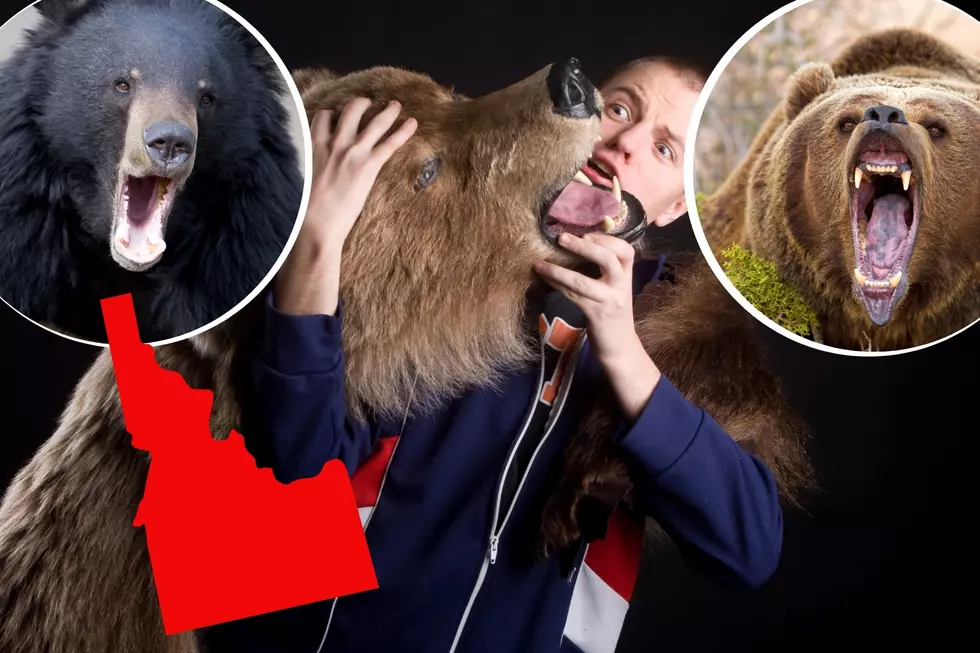
Hunger Games: Odds of Being Mauled by a Bear in Idaho
Between social media trends and recent Fish and Game warnings about attracting wild animals like bears in the Idaho backcountry, we thought it might be a good time to crunch some numbers and figure out just what the odds are of being mauled by a bear, in Idaho. And if you are one of the unfortunate few to experience a mauling, what are your odds of surviving?
Bear Species and Risks in Idaho
In Idaho, the most commonly encountered bear species are black bears and grizzly bears, each with distinct behaviors and risks associated with them. Black bears are widespread across North America and generally less aggressive than grizzly bears, which are larger and can be more dangerous if provoked. Although both pose a risk, the likelihood of a fatal attack is extremely low. Statistics show that there have only been 180 fatal bear attacks in North America since 1784, highlighting the rarity of such events.
Comparing Black, Brown, and Grizzly Bears
Black Bears: These are the most numerous in North America, including Idaho. Fatal attacks by black bears are rare with only 66 fatal incidents recorded since 1784. They are generally less likely to attack humans aggressively and often retreat when encountered.
Grizzly Bears: Known for their strength and size, grizzly bears are less common than black bears in Idaho but pose a higher risk of aggressive behavior. Since 1784, there have been 82 fatal incidents involving grizzly bears in North America. Their territories are mostly confined to the northern Rocky Mountains and parts of Canada.
Brown Bears: Often used interchangeably with grizzlies in North America, these bears are responsible for the highest number of fatal attacks in regions they inhabit, particularly in Alaska and Western Canada.
Safety Tips for Avoiding Bear Encounters
To minimize the risk of a bear encounter, experts recommend:
Make noise while hiking to avoid surprising bears. Bears have a great sense of smell, so keep your food and garbage secured and odor-free, and utilize bear-proof containers when you go camping. Simply being mindful of your surroundings can help avoid contact. When you’re in their habitat; the mere exception that you might encounter a bear can keep you at ready, should the unlikely encounter occur.
What to Do If You Encounter a Bear
If you do encounter a bear, the response should vary depending on the bear you cross paths with.
- Black Bears: Do not play dead. Try to back away slowly and fight back if attacked.
- Grizzly Bears: Play dead if attacked, lying flat on your stomach and clasping your hands over the neck. Fight back only if the attack persists.
Defensive Tools and Measures
In terms of personal defense, bear spray is highly recommended as it's effective in deterring bears from a safe distance. For those trained in firearm use, carrying a gun can be an option, though non-lethal measures are preferred. Firearms suitable for bear defense typically include high-caliber rifles or shotguns. If you prefer to carry a handgun, a .44 Magnum is one of the more popular choices due to its stopping power. If you carry, weapons should be handled responsibly and in accordance with local laws.
Surviving an Attack: Are the Odds in Your Favor?
While the thought of bear encounters can be frightening, the actual risk of being mauled by a bear in Idaho or elsewhere in North America is low, especially when compared to other wildlife or domestic animal encounters. For perspective, the National Park Service estimates the odds of being attacked by a bear are about one in 2.1 million. And if you are attacked, the odds of survival are better than you’d think. Specifically, about 11.5% of grizzly bear attacks have been fatal in the United States between 2000 and 2015, which translates to around 21 fatal attacks out of 183 recorded incidents during that period.
For black bears, the data from 2000 to 2017 shows an even lower fatality rate, with 46 fatal bear attacks leading to 48 deaths across North America, indicating a small number of fatal outcomes relative to the number of overall attacks.
In contrast, the risk of being bitten by a domestic dog is significantly higher, with millions of dog bite cases reported annually in the United States alone. The odds of dying from a bee sting or a lightning strike are notably higher than those of a fatal bear attack.
Avoiding Bear Encounters is Your Safest Bet
To ensure safety in bear habitats, take simple precautions such as making noise while hiking, securing food, and carrying bear spray. By staying informed and prepared, you can safely enjoy the natural environments that bears call home, with minimal risk of negative encounters. Remember, respect and caution are key when sharing spaces with wildlife.
Which Idaho Raptors are a Threat to Your Pets
Gallery Credit: Brad - Canva



